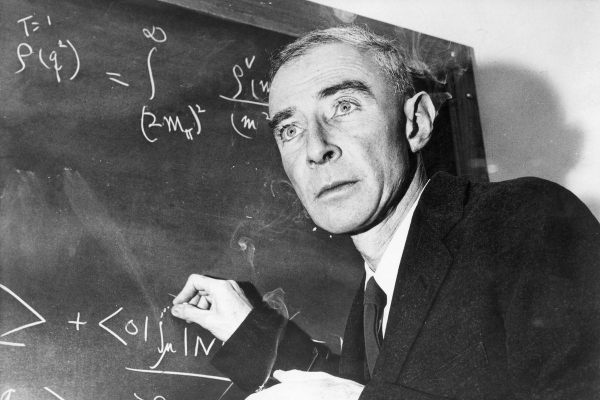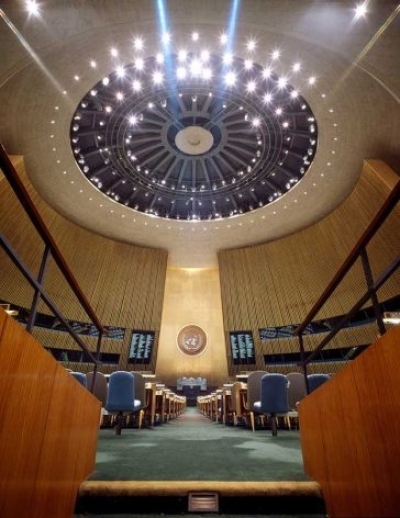The atomic bombings of Hiroshima and Nagasaki still have the power to shock: In an instant, the US killed more than a hundred thousand people. But even if the director Christopher Nolan fictionalized some of the story Oppenheimer, his biopic of the scientist behind the Manhattan Project, the film may spark a new conversation about a history many of us studied in high school, but that often fails to resonate as it should.
The reality is that 78 years after the first atomic bomb was tested at Trinity Site in New Mexico, we are living in a dangerous nuclear moment. Russian President Vladimir Putin has threatened to use tactical nuclear weapons over the war in Ukraine. China has expanded its own once-small nuclear arsenal, even as it has declined to engage in arms-control treaties with the US, which itself will spend about $750 billion over the next decade revamping its nuclear weapons. Countries in the Middle East, like Saudi Arabia, are vying to create civilian nuclear programs, partially in response to Iran’s efforts in developing nuclear technology.
Can Oppenheimer remind us of these dangers and push us to think critically about how the Manhattan Project has led to this reality? I put that question to Alex Wellerstein, a historian at the Stevens Institute of Technology in New Jersey and the author of Restricted Data: The History of Nuclear Secrecy in the United States.
Wellerstein told me that Oppenheimer accurately portrays its subject’s personal complexity, unlike previous historical films about him. But the movie also falls into the trap of outdated scholarship in how it dramatizes President Harry Truman’s ultimate decision to use Oppenheimer’s creation on Japan.
One question that Wellerstein often asks his students is, “What are the conditions that you think it would be acceptable for the United States to deliberately burn 100,000 civilians alive? That’s a really ugly question, right? Like, that really gets you into really dark territory. But I like using it because it pushes you out of the familiar justifications, even though it’s actually the same question.”
Nolan does, however, get across some of the key themes. “Oppenheimer’s worst-case scenario for what could happen after the atomic bomb was invented is that we end up in a world where multiple countries have nuclear weapons that could be delivered very quickly,” Wellerstein told me. “We live in that worst nightmare.”
Our conversation has been edited and condensed for clarity.
As a scholar in this field, what do you think the film gets right and wrong?
Nolan goes way inside baseball. It’s interesting to watch it as somebody who has spent quite some time thinking about Oppenheimer, because you see a lot of things you think, “Well, that’s really obscure.” There are a million examples. Some are technical things: They didn’t have to show some of the components that were used in assembling the bomb, but they chose to, and they depicted them accurately. There are a lot of supporting characters who are essentially either unnamed or barely referenced who are clearly meant to represent actual people who have these small roles in the project.
In general, his approach to Oppenheimer is to make him a very complicated figure. And that is not the normal approach to Oppenheimer in fictionalization. Usually they see him as a simple martyr, or as an Icarus-type figure who went too high and then came crashing down.
On the other hand, there are things in it, some of which are wrong, because he clearly chose to do them wrongly, because he needed to for the purposes of the film. So it cuts out a huge chunk of time in its narrative. It jumps from the end of World War II to the Soviet Union getting the bomb. That’s a big jump, because in that time period, Oppenheimer is at his most important point after Los Alamos. He was a very influential policy adviser in the US government at that time. But you can see why Nolan cut it, because it’s a very long film as it is, and he wanted to get to this other crisis point.
There’s another category of things he gets wrong, where I’m not sure he knows he got them wrong. Those are the deeper framing issues that are, in some ways, more important than a lot of the details, in my view, because I don’t really care if you know the name of Oppenheimer’s secretary. To me, that isn’t as important as some of the issues regarding the choices they had in front of them that led to the atomic bomb getting used. There’s an older scholarship represented in Nolan’s film — one that will be very familiar to most people — that is not what most historians who work on this would characterize it as.
What does the new scholarship say about the atom bomb? Where does this film fit into this new scholarship?
The place where things are not in line with the scholarship are on some of the broader framing issues. There’s a whole line of scholarship now that is not new — it’s 20 to 30 years old, or older — which gets into the fact that the standard narrative that most people have about the use of the atomic bombs and World War II is wrong.
We can call that the decision-to-use-the-bomb narrative, like just the idea that Harry Truman very carefully weighed whether to use the bomb or not. It was a question of, “Do you bomb? Or do you invade?” And so with a heavy heart, he chose to bomb and that was the lesser of two evils. That is just 100 percent not what happened at the time.
It’s much less rationalized and thought out. They were planning to bomb and invade. And they didn’t know what the future would be. And Truman played very little role in all of this. This isn’t news to any scholars, but it hasn’t penetrated popular culture. And it’s not in this film at all.
:no_upscale()/cdn.vox-cdn.com/uploads/chorus_asset/file/24797723/566461865.jpg)
How much of a game-changer is this new scholarship?
In the United States, in particular, we don’t just talk about the history of the atomic bomb because we’re interested in historical facts. We talk about it because it’s one of those core historical episodes that we use to think about what it means to be the United States of America, and also what kind of moral compass the country has.
So a lot of the discussions we have about the decision to use the atomic bomb — in elementary schools and high schools and even in college — it’s really a question of, if you have two bad options in front of you, are you allowed to take one of them? Are you forced to take one? So it’s about, what are the conditions in which you were allowed to destroy an entire city?
And when we construct it that way, we are actually repeating a bad version of history that was invented by people trying to justify the use of the atomic bomb. Because if you get into the situation where you’re saying, is it better to use the atomic bomb or is it better to have this horrible, terrible invasion that will kill some giant number of people, it’s really hard to conclude that the atomic bomb wasn’t justified.
That wasn’t how it was seen in 1945. One of the questions that often comes up is, did they have to use two bombs? Why Nagasaki, so soon after Hiroshima? There’s a whole way to justify that in this rational language: you say, the first bomb was to prove we had one; the second was to prove that we had more than one. And we had to do it because the Japanese didn’t respond to Hiroshima. So it was necessary. And that’s why they chose to do it. That’s all false.
It’s false in the sense that there was no strategic choice about Nagasaki. Truman didn’t even know Nagasaki was going to happen. The [military] people on the island Tinian, who were in charge of dropping the bombs, had an order that they could drop the bombs as soon as they were ready to use, and they happened to have two bombs ready at about the same time. They got a weather forecast that said the planned date for the second bombing was going to have bad weather. So they moved it up a day to accommodate the weather. It had nothing to do with high-level strategy.
The Japanese were, at this time, still trying to figure out what had happened at Hiroshima. They hadn’t actually concluded or even deliberated about it in any formal way. It wasn’t part of some grand scheme. It complicates the discussion quite a bit when you know those details.
What are some of the questions that you and your colleagues are grappling with around the set of issues right now?
I find it really useful, for example, to ask questions about what did people know when they knew about the bomb? We might call this an epistemological approach. Instead of taking for granted that people saw this, the way we might see it, we might look at what they really saw at different moments.
There’s a colleague of mine at Princeton named Michael Gordin, and he has a book called Five Days in August: How World War II Became a Nuclear War, which is all about how people thought about the atomic bomb in-between Hiroshima and the surrender of Japan. At that point, it’s not clear that the bomb has actually ended the war. And if that is the case, then your feelings on, “Well, is it some world-changing weapon or is it just a really efficient way of doing what they could already do?” [A single night of incendiary bombing killed more than 100,000 people in Tokyo on March 9, 1945.]
So those guys on the island who decided to go ahead with the Nagasaki mission on their own choice, they see it as just another weapon. Whereas there are other people, including some of the politicians, who do not see it that way. They see it as this really core political strategic device. Once the war ends, the bomb as a special political thing, that viewpoint wins out. Looking at how people’s attitudes change, you can get a lot out of that.
Then there are questions about, you know, how the bomb becomes not usable — what is called the “nuclear taboo.” This is Nina Tannenwald. [a Brown University political scientist who has researched why nuclear weapons have not been used since 1945.] How does the idea come about that you shouldn’t use nuclear weapons? And when does that come about? And why does it come about? Because it’s not obvious that it has to be that.
My next book is all about, how did Truman understand the bomb, and what was going on in World War II, going from the assumption that everybody’s understanding is incomplete to some degree. And I would argue his was incredibly incomplete. And if you start not assuming that people understood things, but looking at the process of how they think about them, or learn things, you find all sorts of interesting stuff.
That timeline is really compressed between Hiroshima and Nagasaki, if you start looking practically at like, what exactly is happening, and how do you actually confirm a fact? To me, these lead you to all sorts of new questions and new insights, that are just not part of the older scholarship,
What about the perspective of US military leadership? I’m thinking of former Defense Secretary Robert McNamara’s remarks in the Fog of War documentary, where he says, we “were behaving as war criminals. [Air Force General Curtis] LeMay recognized that what he was doing would be thought immoral if his side had lost. But what makes it immoral if you lose and not immoral if you win?”
We have a lot of almost cultural defense mechanisms, to avoid talking about things of that nature.
US policy during World War II included the deliberate targeting of civilians, included burning hundreds of thousands of people alive, many of whom had no choice in the war and had no ability to stop it even if they had wanted to. Of course, we have all these ways of justifying that, some of which are more or less true, some of which are just false. And some of which are just repeating fake justifications that were given at the time, like the idea that they had broken up all their production into little bits and the houses were actually, each of them, a little factory. And it turns out, that’s not true. It turns out, that was never really true. And they just made that up to justify it.
It’s really hard to get Americans to engage with the ugly aspects of it. And I think it’s also tricky, because even if you can get them to engage with it, and really see it for what it is, they’re very quick to then move to essentially justify it. And to say, well, “That’s what you have to do in war, or that’s what the other guy was doing — really awful things, too.” And neither of those are really strong moral justifications or positions.
When I teach, I like to ask students, instead of asking, “were the atomic bombs justified?” because that just provokes the same arguments that you would see over and over again, I instead ask, “What are the conditions that you think it would be acceptable for the United States to deliberately burn 100,000 civilians alive?” That’s a really ugly question, right? Like, that really gets you into really dark territory. But I like using it because it pushes you out of the familiar justifications, even though it’s actually the same question.
For audiences who aren’t familiar with this history, what questions do you think this film should spark? We’re at this incredibly dangerous nuclear moment with Russia threatening to use tactical nuclear weapons, without arms control agreements with China, and so forth.
One of the things they do get across in the movie effectively: Oppenheimer’s worst-case scenario for what could happen after the atomic bomb was invented is that we end up in a world where multiple countries have nuclear weapons that could be delivered very quickly. And they’re very large, and they’re in great quantities. And we’ve entered into a situation that over the long-term is not likely to be permanently stable. And if it becomes unstable, there’s a high chance of just, you know, disaster.
We live in that worst nightmare. We live in it.
That was what he was distraught about as time went on, not so much what he did in World War II, but what they couldn’t do afterwards, which was rein that nightmare in. I would like people to consider that the way things are, is not the only way they have to be.
We need to think in terms of, what’s the world we would like, and figure out how you get there, as opposed to just saying, well, it’s got to be the way it is, which really is a way to just disengage.
If you disengage, then the only people who are really making decisions on this issue are going to be the people who have a lot to gain from it. And that’s how you end up in a situation with arms races, when the military, Congress, and contractors are making a lot of the decisions.






